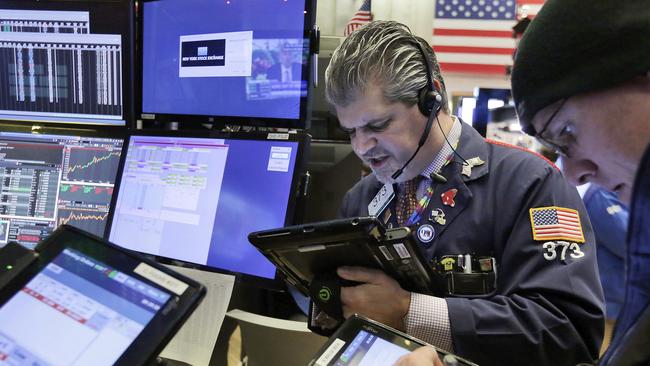Markets, economies, facing a watershed year

At the centre will be the actions of the key central banks, with 2018 the watershed year for the post-crisis era.
Since the GFC the central banks of the US, eurozone, UK and Japan have injected tens of trillions of dollars into the global system, forcing bond yields to historically low levels, indeed into negative territory in some jurisdictions, and encouraging/coercing investors into increasingly riskier assets.
This is the year when those central banks start to pivot. The US Federal Reserve, whose bond and mortgage buying under its quantitative easing programs peaked at $US85 billion a month, will be withdrawing liquidity rather than injecting it at a rate of $US50 billion a month by the end of the year.
The European Central Bank, having already trimmed its asset purchases from €80 billion a month to €60 billion a month, this month will halve the level of activity to €30 billion a month. There is an expectation that it will taper the program further as the year progresses and that it may even announced an end-date for its bond purchases before the end of the year.

The Bank of Japan, which has run the largest and longest of the QE programs, surprised everyone this week when it reduced its purchases of long-dated bonds by ¥10 billion and signalled that it will scale back its future long-bond buying by five per cent.
Having been the dominant buyers of government bonds since the crisis — they’ve effectively bought the equivalent of all the government bonds issued by the major developed economies in the past few years — the key central banks’ presence in the markets is going to shrink quite rapidly, if all goes according to plan.
While their actions aren’t synchronised — the Fed is way ahead of the others in unwinding its balance sheet legacy from the QE programs — they are heading in the same direction. That’s because, for the first time since the crisis the developed world economies — including Japan’s — are experiencing synchronised and quite solid growth.
While that’s good news for everyone, it also means that the excess liquidity sloshing around global markets will gradually be withdrawn and, absent another shock or crisis, that the ultra-low rate environment of the post-crisis period will also gradually give way to still-low but rising rates.
The Fed, having already raised the federal funds rate five times from its nadir, has foreshadowed three more rate rises this year.
There may be more, if the Trump administration’s tax cuts — estimated to add between $US1 trillion and $US1.5 trillion to US deficits over the next decade — tend to be overly stimulatory to an economy already showing some signs of nearing its capacity limits.
With Trump’s infrastructure agenda the administration’s priority for the first part of this year, the potential for even more stimulus (and bigger deficits to be funded via bond issues) is real, as is the prospect of the Fed moving US rates more aggressively than it has flagged.
Higher rates could undermine equity markets that Citi’s chief economist, Willem Buiter, has said are clearly showing signs of “late-cycle froth’’.
With Treasury bond yields surging this week to levels matching their highest since the crisis, and US equity markets continuing to post records, two-year bond yields of 1.97 per cent are above the yield of the S & P 500 of 1.84 per cent.
Having been increasingly forced by the central banks into higher-yielding but more risky assets, if yields continue to rise risk-averse investors may start to switch their focus from equities to bonds.
Rising rates around the world at a time when global debt is more than three times global GDP but where the spreads between the yields of government and corporate debt, even junk debt, have been compressed to historically low levels could bring with them some unpleasant consequences, but the growth in the core of the global economy they would reflect would obviously be a very positive development.
The bond markets do provide something of an insight into the wider environment.
There was a spike in US bond yields last night after Bloomberg reported that senior government officials in China had recommended slowing or halting purchases of US Treasuries. China, with Japan, is America’s biggest creditor, holding just over $US1 trillion of US Government bonds.
While China’s exposure to US debt hasn’t materially increased in recent years — it has been trying to diversify its foreign exchange reserves — the report was interpreted as a veiled threat by the Chinese to reduce the demand for US government securities at a time when the Trump policies will result in a flood of new supply.
It may not be a coincidence that the US administration is close to a decision on whether to impose punitive trade penalties on Chinese products.
A China-inspired rise in US bond yields would, of course, impose potentially very large losses on China’s US bond holdings, so it might just be a bluff.
Nevertheless, it does underscore the potential for the trade tensions that were anticipated if the US administration did try to implement the protectionist “America First’’ policies promised by Donald Trump to unsettle and undermine financial markets.

It’s not only China where Trump’s trade policies could have a significant impact. Canadian and Mexican currencies and stocks fell yesterday after Reuters reported that Canada was convinced the US would announce that it intends to pull out of the North American Free Trade Agreement.
The three countries have been holding talks, instigated by the US, on “modernising’’ NAFTA, with Trump threatening to simply tear up the agreement unless Canada and Mexico agree to make significant changes that favour the US. Their next meeting is scheduled late this month.
If the US does move to implement Trump’s trade agenda, it also has the potential to spill over into a trade war, not only with China but Europe, which would be harmful to the global economy and financial markets and cause real damage to multinational companies with global supply chains.
There are other issues that could help shape the outlook for markets and economies — geopolitics (North Korea) in particular, the still-simmering populism in Europe, the continued restructuring and deleveraging of China’s economy among them — but interest rates/central bank actions and trade frictions are likely to be among the most influential in determining whether the excessive, central bank-generated, exuberance in financial markets ends in a “soft’’ landing or with a bang.





Less than a fortnight into the New Year we are already seeing some of the key strands of the developments that will shape financial markets and economies this year emerging.